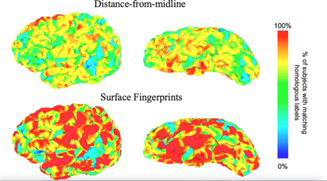November 5, 2023
"Led by LRDC Research Scientist Marc Coutanche, a multi-institutional research team introduces and tests two methods — one anatomical, one functional — that advance the examination of lateralization."
Key Takeaways
- The researchers suggest that a difference in information, measured through multi-voxel pattern analysis (MVPA), is a more comprehensive measure of lateralization
- They argue that the field should consider an information-based approach to lateralization
 The human brain's division into two cortical hemispheres is one of its most visible and clearest organizational principles. Certain cognitive functions are associated with bilateral neural processing, whereas others are frequently lateralized to one hemisphere. For instance, language processing is generally left lateralized, and face processing tends to be lateralized in the right hemisphere.
The human brain's division into two cortical hemispheres is one of its most visible and clearest organizational principles. Certain cognitive functions are associated with bilateral neural processing, whereas others are frequently lateralized to one hemisphere. For instance, language processing is generally left lateralized, and face processing tends to be lateralized in the right hemisphere.
Functional lateralization is commonly measured by comparing the levels of activation observed in the two hemispheres. This 'Blood Oxygenation Level Dependent (BOLD)' activity signals that a region is processing the conditions of interest. Most commonly for studies of lateralization, task-driven activity from the left and right hemispheres are observed, recorded, and statistically compared.
Another form of analysis, multi-voxel pattern analysis (MVPA), measures information, also made visible by BOLD, across patterns of activity distributed across multiple voxels. MVPA is often referred to as "pattern decoding," and is particularly useful for investigating how specific perceptual categories, such as faces, are encoded in cortex, including at the level of sub-categories or exemplars.
Significant additional information exists with distributed multi-voxel patterns of activity — a format not detectable by traditional activation-based analysis of functional magnetic resonance imaging (fMRI) data.
Instead of conceiving of lateralization as a difference in functional activation between corresponding voxels in each hemisphere, the authors suggest that a difference in information is a more comprehensive measure of lateralization -- an important advance because two regions can exhibit similar activation levels, but actually contain different amounts, and forms, of information.
How might one assess lateralization of information in multi-voxel patterns? Led by LRDC Research Scientist Marc Coutanche, a multi-institutional research team introduces and tests two methods — one anatomical, one functional — that advance the examination of lateralization. The researchers suggest that a difference in information is a more comprehensive measure of lateralization.
Read their results in the complete article.
Citation: Coutanche, M.N., Sauter, J., Akpan, E., Buckser, R., Vincent, A., & Caulfield, M.K. (2023). Novel approaches to functional lateralization: Assessing information in activity patterns across hemispheres and more accurately identifying structural homologues. Neuropsychologia.

